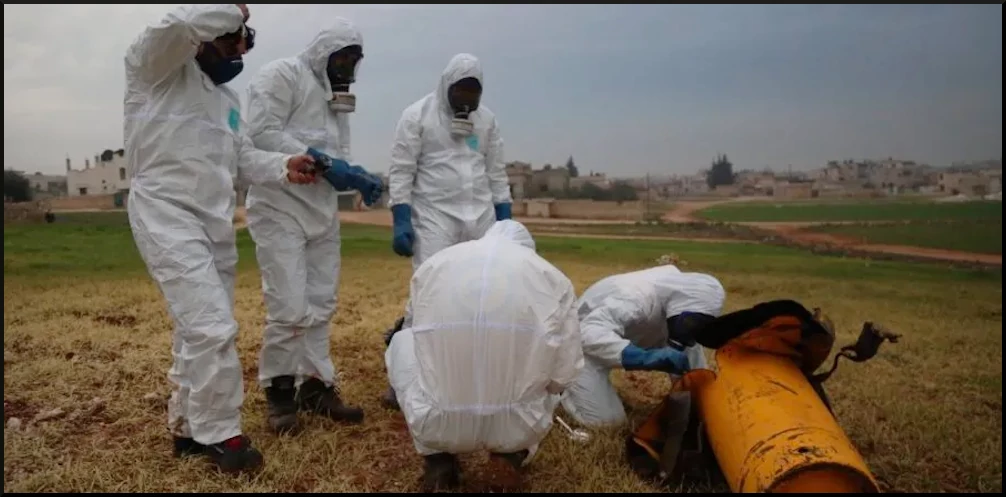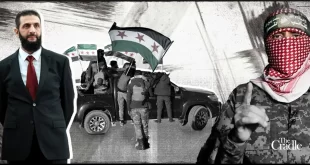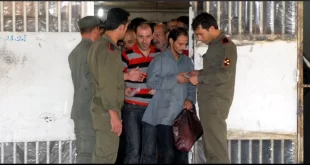by , published on Aaron’s Substack, September 9, 2022
Syria is largely forgotten by US people whose attention is at present largely engaged in Ukraine, and maybe Taiwan. And so the trail of lies seems to vaporize behind the forward edge of U.S. aggression around the globe. But fortunately, there are those, like Aaron who did not, and will not forget, and who continue to pursue the truth against all odds. Thank you Aaron. [ed]
Before it mired the Organisation for the Prohibition of Chemical Weapons (OPCW) in an international cover-up scandal, the April 2018 probe of an alleged gas attack in the Syrian town of Douma achieved a milestone. After numerous claims of chemical weapons use in Syria, Douma marked the first time that an OPCW fact-finding mission (FFM) deployed on-site to conduct its own investigation.
Douma was not the OPCW’s first try. Four years earlier, in May 2014, the chemical watchdog sent a team to the town of Kafr Zita. As in Douma, the organization was mandated to scrutinize insurgent-generated claims of a toxic bombing by the Syrian army. But unlike in Douma, the OPCW never reached its destination. After a roadside bomb hit the OPCW’s four-vehicle convoy, armed insurgents opened fire and briefly kidnapped the inspectors.
The assault proved fateful. The OPCW abandoned not only the Kafr Zita mission, but all other on-site deployments in Syria going forward. It was not until the Syrian and Russian armies regained control of Douma in April 2018 — and after another violent attack, this time on a UN security team — that the OPCW would get back on the ground.
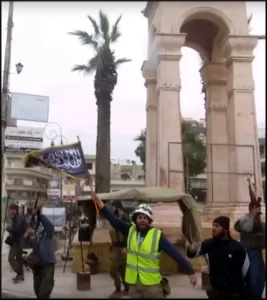
The four-year period between Kafr Zita and Douma, however, did not put an end to the OPCW’s investigations in Syria. No longer sending its own staff into a war zone, the OPCW outsourced its duties to groups still able to operate there. Most of these missions concerned alleged chemical attacks in insurgent-controlled territory, where the Syrian government was always the accused culprit. In such cases, one of the OPCW’s main newfound proxies was a group known as the White Helmets.
As an OPCW partner, the White Helmets carried out many of the sidelined scientists’ normal tasks. White Helmets members identified sampling locations; collected and tagged the samples; gathered video and photo evidence; and, in some cases, selected witnesses for interview. They then traveled to the neighboring Turkish border and handed material to OPCW staffers operating out of hotels. Some White Helmets members even claimed to be victims or witnesses of chemical attacks, and provided their testimony.
In enlisting the White Helmets, the OPCW pointed to the group’s claim to be a neutral organization that conducts rescue missions and other life-saving work. But from the outfit’s founding abroad to its activities on the Syrian battlefield, the reality was very different. Far from being impartial, the White Helmets were allies of – and funded by – belligerents in the Syria dirty war. And in the OPCW investigations in which the White Helmets participated, this overlooked conflict of interest shaped the outcome in their side’s favor.
The White Helmets were established in Turkey by the late James Le Mesurier, a British military veteran, and his then-employer, the Western intelligence contractor Analysis, Research, and Knowledge, or ARK. With funding from the State Department and UK Foreign Office, ARK “branded the White Helmets and provided its training and equipment,” according to a 2019 report in The Intercept. The US and UK governments have funded the White Helmets to the tune of $70 million since 2014. Millions more have flowed into its coffers from NATO and Gulf allies.
Over the same period, footage and media coverage of the White Helmets – including an Oscar-winning documentary – has been used to drum up Western public support for these same states’ multi-billion dollar covert military campaign to overthrow the Syrian government. White Helmets leaders have even lobbied for direct Western military intervention on the insurgents’ side.
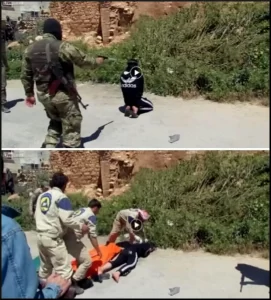
Inside Syria, the White Helmets have cooperated with insurgent militias and operated exclusively in territory under their control. White Helmets members celebrated Al-Qaeda’s 2015 conquest of Idlib province, participated openly in executions carried out by militants, and posed gleefully with the corpses of Syrian soldiers. In 2016, an influential Al-Qaeda cleric said the group is “no different” than Syria’s “mujahideen.” The following year, a top Al-Qaeda leader in Syria praised the White Helmets as “hidden soldiers.” In 2018, the White Helmets collaborated with the Turkish military’s ethnic cleansing operation in the majority-Kurdish northern Syrian city of Afrin, drawing local outrage.
The White Helmets’ insurgent ties have even unnerved some of their state backers. In 2018, the Netherlands became the first government to suspend funding for the White Helmets, citing inadequate monitoring and the “danger” that money could fall “into the hands of armed groups,” including Al Qaeda. The following year, Le Mesurier, the White Helmets founder, died in an apparent suicide days after admitting to pocketing donor money and trying to conceal it.
The White Helmets and its supporters have described the group’s insurgent ties as an aberration, a necessary compromise to save lives in areas under Syrian-Russian bombardment, and even “Russian disinformation.” But for the OPCW, the White Helmets’ foreign sponsorship alone created a conflict of interest that has escaped wide scrutiny.
In partnering with the White Helmets, the OPCW enlisted a group backed by states that armed anti-government insurgents, making them belligerents in the Syria conflict. These same states accused the Syrian government of chemical attacks while funding the White Helmets. The White Helmets were in turn tasked with validating these allegations for the OPCW — in some cases, for allegations that its members had initially spread.
The OPCW-White Helmets arrangement would have been akin to the OPCW subcontracting external organizations founded and funded by the Syrian government’s allies, Russia and Iran, to help investigate alleged chemical attacks that they blamed on insurgent foes.
Teaming up with the White Helmets not only required the OPCW to abandon its impartiality, but to also ignore its most fundamental standards for the collection and analysis of evidence.
From a distance, the OPCW’s enlistment of the White Helmets could be seen as a practical solution to the perilous security climate in Syria. Properly trained, a group with free rein to move through insurgent-held territory without fear of attack could theoretically do the work that OPCW inspectors no longer could after the violent kidnapping in Kafr Zita.
But this seeming workaround violated the OPCW’s core protocol for chemical weapons probes. To ensure full confidence in the integrity of samples gathered for chemical analysis, the OPCW requires that physical evidence collection strictly ensure “chain of custody.” This means that OPCW inspectors must have full control of samples from the time that they are gathered at the site of an alleged chemical attack until they are delivered to international forensic laboratories for analysis.
The OPCW’s documented procedures are unequivocal about this. If a “sample was not under OPCW custody” at any point during a mission, OPCW policy states, it “will not be accepted for OPCW verification purposes.” The OPCW’s chain of custody requirements are so stringent that any inspector “who is not specifically assigned for evidence-related tasks” is not allowed to “deal with any item linked to an investigation site.”
In early Syria operations, the OPCW adhered to these standards. When Western and Israeli officials began accusing the Syrian government of chemical weapons use – an alleged violation of President Obama’s so-called “red line” — the OPCW laid down a red line of its own. “The OPCW would never get involved in testing samples that our own inspectors don’t gather in the field, because we need to maintain chain of custody of samples from the field to the lab to ensure their integrity,” OPCW spokesperson Michael Luhan said in April 2013.
“We [the OPCW] were really considered the only ones that could go in there with the chain of custody and with that integrity and retrieve true facts that could stand up to scrutiny in larger arenas,” Scott Cairns, the OPCW team leader for the OPCW/UN investigation into the 2013 Ghouta sarin attack in Syria, noted that same year.
Accordingly, the OPCW’s initial Fact-Finding Missions (FFMs) in Syria rejected samples that OPCW inspectors had not collected themselves. In a December 2014 report on several alleged incidents, including Kafr Zita, team leader Malik Ellahi noted that certain samples “could not be accepted on account of chain of custody issues.”
Unbroken chain of custody, therefore, is the standard underpinning the integrity of OPCW investigations. When the OPCW outsourced its evidence collection duties in Syria to third parties starting in 2015, it abandoned this bedrock protocol. Samples that would have previously been disqualified were now welcome.
The OPCW’s new sample collectors included the White Helmets.
An October 2015 report about several alleged chemical weapons incidents in Syria introduced the White Helmets to the OPCW fold.
The report noted “many references to the Syrian Civil Defense (SCD)” — the White Helmets’ official name. To apparently vouch for the White Helmets’ credibility, the OPCW reproduced a quote from the group’s website, in which it claims to “act neutrally, impartially,” as “humanitarians.”
Beyond visiting the White Helmets’ homepage, there is no indication that the OPCW conducted any additional vetting of the organization, or raised any concerns about its new Western-funded, insurgent-allied field team.
When it came to handling the potential evidence from samples gathered by the White Helmets and other external groups, the OPCW at first attempted to portray a cautious approach. The report claimed that evidence from remotely gathered samples would be treated as “tertiary”, only to be used as “supporting evidence.” As there was no chain of custody, the team had no certainty that the samples had not been contaminated (accidentally or deliberately) before handover to OPCW investigators.
The 2015 report appeared to acknowledge this point:
[t]he entire chain of custody could not be verified, thus the possibility of cross-contamination could not be ruled out. Therefore, although such samples would be considered as primary evidence under optimal circumstances, given the constraints as described, the FFM regarded the samples as tertiary evidence. As such, the results from such analyses were treated more as supporting information than of significant evidential value.
But even in treating such “tertiary” evidence as “supporting evidence,” the OPCW distorted its own definition.
Under OPCW protocol, tertiary evidence is defined as “evidence that is still developing as an analysis capability,” and that “is merely a useful reconnaissance indicator,” – for example, identifying potential locations of interest – “or may be potentially ambiguous.” Nowhere is it described as potentially “supporting information.” This seemingly cautious approach is also based on a faulty premise: that the White Helmets could be trusted not to have tampered with or provided fake samples in the first place.
When it came to abandoning the OPCW’s commitment to a chain of custody in Syria, the “tertiary” category would prove to be just a first step. With time, any trace of skepticism about the integrity of the White Helmets’ samples would evaporate.
By 2017, the OPCW gave the White Helmets and the material it collected a full upgrade. FFM reports now referred to White Helmets operatives as the “Chemical Sample Unit.” Though no chain of custody had been established, the samples furnished by the White Helmets were suddenly treated as primary evidence.
In April 2017, insurgents in the Al Qaeda-controlled town of Khan Shaykhoun accused the Syrian government of dropping a sarin-filled bomb and killing over 80 people. The White Helmets helped spread the allegation by releasing photos of victims allegedly suffering from nerve agent exposure. Within days, the US endorsed the insurgents’ claims and launched airstrikes on Syria.
In the aftermath of the US bombing, the OPCW investigated the incident from neighboring Turkey. Inside Syria, White Helmets members gathered alleged evidence and brought it across the border. According to the BBC’s Chloe Hadjimatheou, a self-described journalist with ties to UK-backed intelligence operatives and insurgents in Syria, White Helmets founder James Le Mesurier worked alongside the group and helped select witnesses.
The OPCW FFM’s June 2017 report on the incident effectively endorsed the stated pretext for US air strikes by concluding that sarin was “used as a weapon” in Khan Shaykhun. That finding, the OPCW stated, was based on factors including the “analysis of environmental samples.”
At the same time, however, the report acknowledged that “the entire chain of custody” for those samples “could not be categorically verified.” For the environmental and biological-environmental samples taken at the site of the alleged attack and analyzed by the OPCW’s Designated Laboratories, the report stated, “all samples were taken by the chemical sample unit of the SCD [White Helmets].”
Without explanation, samples collected by the White Helmets for the OPCW in Khan Shaykhun were granted full evidentiary status. Subsequent reports likewise treated White Helmets-collected samples no differently than had they been gathered by the organization’s own inspectors.
In a May 2018 report on an alleged chemical attack in Saraqib three months earlier, the OPCW again noted that “all samples had been taken by the SCD [White Helmets].” These samples played a critical role in the report’s conclusion. Endorsing the allegation spread by insurgents, the OPCW declared that chlorine “was likely used as a chemical weapon,” in Saraqib.
The factors underpinning this conclusion, the report said, included an “analysis of environmental samples… demonstrating the unusual presence of chlorine in the local environment.”
Gone, once again, was not only the foundational OPCW protocol that would have ruled these samples to be inadmissible. The ploy of downgrading them to “tertiary” or “supporting information” was discarded as well.
The OPCW relied on witnesses often supplied by the White Helmets, or who were White Helmets members themselves. Many reports carried a standard caveat that states:
As with other allegations investigated by the FFM, the team was not able to visit a secured site immediately after the alleged incident. [T]he team therefore relied on the testimony of interviewees, samples as made available by the interviewees, and limited hospital records.
Original hospital records were not just limited, but in many cases unavailable. This meant that the outcomes of investigations were decided on samples provided by the White Helmets; on testimony from the White Helmets; and on testimony from other alleged witnesses also provided by the White Helmets or other third parties.
Interviews of alleged witnesses were in fact central to multiple probes where no samples were provided. In Idlib province, captured by Al Qaeda in May 2015 and therefore off-limits to OPCW inspectors, several investigations had no biological or environmental samples at all. The OPCW’s report on these incidents noted their evidentiary gaps:
The inability of the team to visit the scene due to significant security issues, however, created several deviations from the ideal. Thus, the team could neither identify their own witnesses nor take their own sample[s].
Along with sample collection, the key investigative pillar of witness testimony — now in many cases the only source of evidence for the alleged attacks — was also in external hands. And it showed.
In one investigation of an alleged May 2018 chemical attack in Saraqib, in Idlib province, said to have caused around 70 victims, six individuals were interviewed. Five of them were “first responders,” – most likely White Helmets — and the sixth a member of the local media. The OPCW noted that none of the six were in Saraqib “during the incident,” but in the nearby town of Sarmin. The report also noted that the testimony was not “first hand” and that it “could not cross-check this information from different sources such as medical professionals, victims, casualties and direct witnesses.” On top of that, no biomedical and environmental samples were “collected or received.”
The Saraqib investigation therefore relied entirely on the testimonies of six people whose accounts could not be verified, and whose impartiality could not be assured.
Yet the OPCW’s overarching conclusion from the “investigation” of these incidents in Idlib was that:
It can therefore be concluded that the evidence received throughout the interview process gave the team a reasonable degree of confidence that a chemical had affected people in various locations in the Idlib Governorate.
Despite relying so extensively on the testimonies of the White Helmets and other alleged witnesses, the OPCW took a lax approach to assessing their credibility. In multiple reports, the OPCW presumed that because it received a consistent account from different interviewees, their collective narrative must have been reliable. As one report put it:
Interviewees gave a consistent narrative of the incident, the reported medical signs and symptoms and the way samples were collected. The FFM was able to place witnesses at the site at the time and correlate their medical assessment. Based on these factors the FFM determined that at least 16 people displayed symptoms associated with exposure to an acetylcholinesterase inhibitor [nerve agent].
The same argument was used across several reports, substituting only the number of casualties and the chemical to which the victims were allegedly exposed. The consistency in narratives is hardly surprising, considering how many witnesses and sample collectors all came from one organization: the White Helmets.
One of the most telling “consistencies” between testimonies comes from an alleged March 2015 sarin attack at al-tamah, where witnesses reported seeing what appears to be an improbable scenario. According to the report:
One witness who inspected the first crater described it as being about 1.5 meters in diameter by one meter in depth. Inside, there was a bubbling liquid and metal fragments. Another witness who saw the crater on the first day described the bubbling liquid as similar to water. Days later, the same crater was seen having a black bubbling liquid.
The idea that sarin – a chemical with a boiling point higher than water – would stay bubbling for days in the porous soil is as hard to fathom as pouring boiling water in soil and expecting it to still be bubbling after minutes, let alone days later. Yet somehow, the world’s top chemical watchdog saw no cause for skepticism.
With many FFM investigations relying on nothing more than testimonial evidence — where many of the interviewees were members of the insurgent-allied White Helmets — corroborating the credibility of such testimonies should have been vital. In Syria, for some unexplained reason, this never took place. Instead, to validate witness accounts, the OPCW’s investigators substituted “corroboration” with “consistency” and presumably hoped that no one would notice.
By enlisting the White Helmets as on-site investigators, the OPCW apparently also hoped that no one would take note of the group’s insurgent ties and foreign sponsors.
In doing so, the OPCW abandoned its stated commitment to impartiality and handed its mandate to one side of the Syria proxy war – the very elements that had attacked its inspectors in May 2014.
And by presenting the White Helmets as neutral, objective partners, the OPCW gave the group’s insurgent allies and foreign sponsors a backchannel to influence investigations critical to the goals of their decade-long war to overthrow the Syrian government. The allegations that Syria has used chemical weapons against its own people have been used to help justify sustained proxy warfare, sanctions, and, in two consecutive years, US-led military airstrikes.
In the most controversial of such incidents, the alleged Douma chemical attack of April 2018, the OPCW managed to send its own inspectors to the scene. But as the second part of this report will show, the ever-present White Helmets compromised the OPCW’s investigation yet again.
*Featured Image: Members of the White Helmets’ “Chemical Sample Unit” in Saraqib, February 2018. (UK Foreign, Commonwealth & Development Office)
Aaron ‘s work can be found on his substack at mate.substack.com, at The Grayzone and on youtube. He has recently been appearing a couple of times a week with Katie Halper on Useful Idiots. Do follow his work wherever possible.
 Syria Support Movement solidarity with the Syrian people
Syria Support Movement solidarity with the Syrian people

